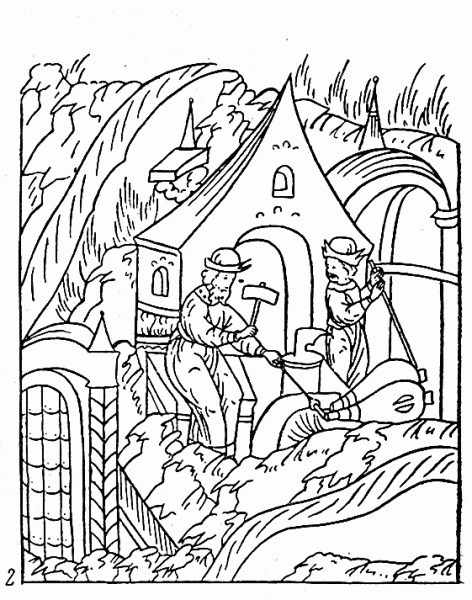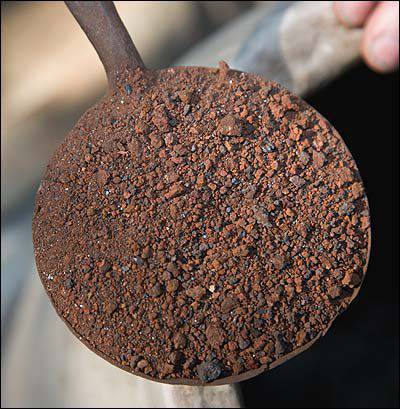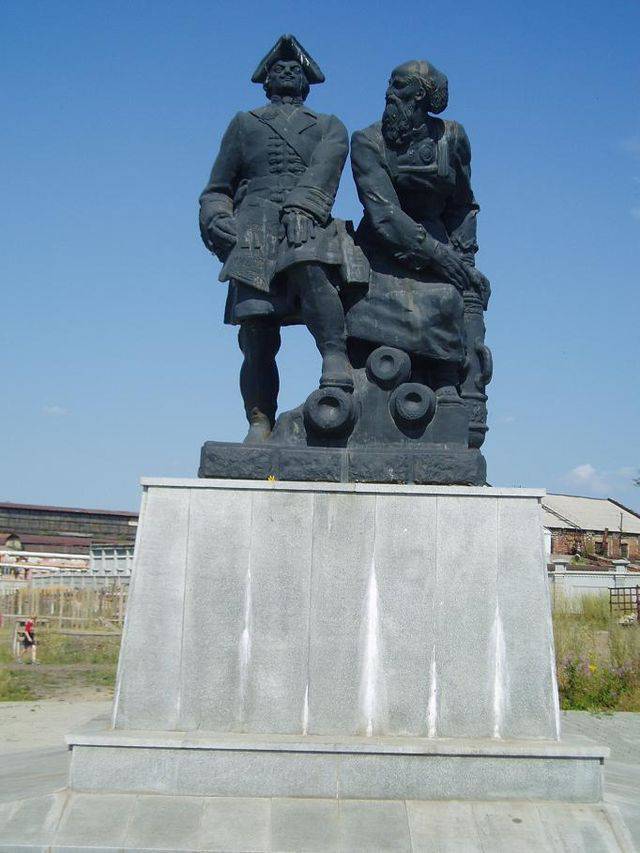From the history of Russian metallurgy
Of stories Russian metallurgy
The production of iron in the territory of Russia has been known since ancient times. Archaeologists have found in areas adjacent to Kiev, Pereyaslavl, Vyshgorod, Murom, Ryazan, Vladimir, Yaroslavl, Smolensk, Pskov, Novgorod and other ancient Russian cities, as well as Lake Ladoga and other areas, hundreds of places with the remains of smelting pots, cheese-making hills (t. “Wolf pits”) and the corresponding tools for the production of metallurgy.
Developed metallurgy was also in Scythia, the direct successor of which was Russia. A coin dated to the beginning of the 9th century was discovered in one of the “wolf holes” dug for smelting metal near the village of Podmokly in the southern part of the Moscow coal basin. That is, metallurgy in Russia existed even before the introduction of Christianity. The surnames of the Russian people also speak of the ubiquity of metallurgy in Russia: Koval, Kovalenko, Kovalchuk, Kovalev, Kuznetsov. Mythology and folklore of the Russian people, where the blacksmith is one of the central figures fighting against evil and representing celestial forces, also confirm the development of metallurgy in Ancient Russia.
For the production of metal requires two main factors: fuel and raw materials. The main fuel at that time was charcoal. The highest quality charcoal was obtained from relatively rare and hardwood species - oak, beech and hornbeam, as well as birch. Iron smelting required a huge amount of wood: it took almost 40 cubic meters of wood to process one ton of ore. More technological replacement of charcoal - coke, appeared relatively recently (two hundred years). An interesting fact is that initially it was the absence of significant tracts of forest that prevented England from becoming the main producer of metal in Europe. The increase in iron smelting in England wiped out almost all large forests.
Fuel in Russia was. Since ancient times, the forest has been the main fuel and building material on our land. But there were problems with iron. There is no affordable high-quality iron ore on the Russian Plain. The Kursk Magnetic Anomaly was discovered only in the XX century and the depth of the 200-600 meters there. Technologies of that time did not allow developing such deposits. Humanity knows: magnetic iron ore (more than 70% iron), red iron ore (55-60%), brown iron ore (limonite, 35-55%) and spar iron ore (40%). Magnetite and hematite on the Russian platform are deep, and there is no spar bite at all. Therefore, only brown iron ore remained. Raw material is bad, but its plus is that it was almost everywhere. "Marsh iron" (limonite) was mined in peat bogs. A swamp located among the then mighty forests of Russia. Thus, metallurgy could be developed everywhere.
True, the Europeans are more fortunate. Rich deposits of iron and other metals were there in the mountains in Germany, the Czech Republic. Mass mining of metal ores by mining in the German lands began in the XIII century. By the beginning of the XVI century in Germany there was a powerful metallurgical production, which produced base metals (iron, copper, silver and gold). In the 16th century, massive exports of iron and copper from Sweden began. Sweden possessed rich deposits of iron ore and for two centuries firmly occupied the first place in the supply of iron and copper. So far, thanks to the Urals, Russia has not outstripped her.
“Marsh iron” is formed practically everywhere where the transition from oxygen-containing soils to an oxygen-free layer takes place (at the junction of two layers). In the swamps, this boundary is located very close to the surface, iron nodules can be dug with a shovel, removing a thin layer of vegetation and earth. The deposits of such iron are classical placers and can be developed with a minimum of effort.
For the cheese-making process, which was used by metallurgists of Ancient Russia, iron-rich ore was required. And limonite ore is poor. Therefore, the marsh ore going to smelting, necessarily enriched. Among the methods of ore beneficiation were: drying, roasting, grinding, washing and sieving. Thus, the availability of fuel and raw materials, as well as enrichment technologies, led to the fact that Russia has been a country of gunsmiths since ancient times. It is safe to say that Russian metallurgy allowed Russia to survive a thousand years in hundreds of wars of varying intensity, from local conflicts to full-scale regional wars. Military production since ancient times was the core of the Russian state.
"Marsh iron" was the basis of metallurgy of Russia until the XVII century. At the end of the Old Russian state, whole areas appeared that specialized in the production of iron. In the modern Kursk region, iron was produced in the city of Rimov. One of the largest centers of metallurgy was in the Novgorod land. Iron was produced in Ustyug Zhelezny (Ustyuzhna Zheleznopolskaya). Marsh iron was mined in the area of the Pit, Koporye, Nut, brought to Novgorod. At the same time, Novgorod also bought iron through Hanseatic merchants in Germany and Sweden. In the XVI century, Zheleznopolskaya Ustyuzhna remained the largest center of metalworking and weapons business in Moscow Russia, iron was also produced in Tula, Tikhvin, Olonets and Zaonezhie.

Extraction of non-ferrous metals in the territory of Russia until the XVIII century was virtually absent. Small sources of copper were in the Olonets region and on the Pechora, but they could not saturate the domestic market. In Novgorod, they knew about the sources of silver in the Urals, but production could not be created then. Therefore, the bulk of non-ferrous metals came to Russia from Europe. Not only iron, but also the bulk of lead, tin, and copper came through Novgorod.
It is clear that this affected the military-strategic position of Russia. Iron and copper were metals of war. With the development of the country of metal required more and more. Western opponents of Russia - Sweden and Poland, used the fact that through them went the main flow of metal into the Russian state and periodically with a view of political pressure and military weakening of Moscow, restricted imports. Therefore, the attempts of the Russian government, starting with Ivan the Terrible and continuing with Peter Alekseevich, “to cut through a window to Europe”, that is, to put under control a part of the Baltic states, were associated with the desire to achieve free trade in the Baltic.
When the British first appeared under Ivan Vasilyevich in the Russian North, Moscow was primarily interested in the possibility of supplies of iron, other metals and weapons bypassing the traditional sea route on the Baltic Sea and the land through Poland. The British then did not see the threat from Russia, were interested in Russian goods and the passage to Persia along the Volga route, so the merchants of the Moscow Campaign began to actively sell nonferrous metals and weapons to Moscow. After the death of Ivan the Terrible, Arkhangelsk was still an important center of metal supply in Russia. They were supplied by English and Dutch merchants.
With the first Romanovs, Moscow actively bought high-quality steel and non-ferrous metals, as well as ready-made guns and gun barrels. However, it was not profitable for Russia. Foreign iron was expensive. If at the beginning of the 17th century one pound (16 kg) of Russian iron cost the manufacturer about 60 kopecks, then the cost of Swedish pud of iron reached 1 rubles. 30 cop Pud of imported iron wire cost even more - up to 3 rubles. For comparison. An ordinary horse was then worth about RUR 2, and the serf could be bought for RUR 3-5. "Strip bulatna" (they were used for the production of sabers) cost about 3 rubles. They were imported from Holland and Persia. Copper brought English, Dutch, Danish and Swedish merchants. Its cost was 1,5-3 rubles, and roofing copper (for church domes) was 6 rubles. Silver and gold were also imported. Silver at the beginning of the XVII century cost about 450 rubles. pud, gold - about 3300 rub. Tin, lead and copper were brought from Germany.
However, the main supplier of high-quality iron for Russia at that time was Sweden. Russia in Sweden bought almost only metals. It is clear that as the relationship between Russia and Sweden deteriorated, the situation became more and more dangerous. The Swedes seized the Russian lands in the Baltic, pushed the Poles back, turning the Baltic Sea into “Swedish Lake”. A powerful metallurgical base made Sweden a powerful military power that threatened the future of Russia.

"Marsh iron"
The development of metallurgy in the Romanovs
As soon as Russia recovered from the Troubles, the Russian government tried to create its own metallurgy. In 1632, Tsar Mikhail Fedorovich gave the Dutch merchant Vinius a patent on the construction of an ironworks in the region of Tula. Production was based on the Didilov mine. It was no longer “bog iron”, but deposits of high-quality iron ore near the village of Didilovo. The issue with the labor force was decided by assigning an entire volost to the enterprise, so the category of assigned peasants began to arise. In addition, “eager people,” that is, freelance workers, also worked at the enterprise. Vinius' enterprise became a real manufactory using machines.
Soon, Vinius was joined by the Dutch merchant Filimon Akema and the Danish from Hamburg, Peter Marcelis. They built three more manufactories in the Tula region ("Gorodische plants"). At the enterprises not only Russians worked, but also masters invited from Europe. Marcelis and Akema built several more iron-making manufactories on the Sknig River (Kashirsky Plants). These iron enterprises became the core of metallurgy in Russia. However, an attempt to launch copper production in Karelia and free itself from expensive imported metal failed. Due to the small reserves of copper, the high complexity of the work and the associated significant costs, the plant was declared unprofitable and closed. True, in the 1680s in Karelia they were able to open five metallurgical manufactories on water energy ("Olonets factories"). Under Peter, these enterprises began to specialize in the interests of the Baltic fleet.

Andrey Denisovich Vinius, engraving by Cornelius Vishera, 1650 year
Since 1693, in the south of Russia, the first iron-smelting plant has been launched using water energy. The metal of the Lipetsk plant was supplied to Voronezh, where Peter built the Azov flotilla. In 1703-1705 production here expanded, there were "Lipsky Iron Plants". They became the metallurgical base of the Azov flotilla and in the first years of the Northern War gave the country half of the metal needed for military production.
However, this was not enough to create a metallurgical base capable of making Russia an advanced European power. “Swamp metal” and rare surface deposits of iron ore on the Russian Plain could not provide sufficient production. A quality jerk was needed. And only the Urals could provide it. Even in ancient times, the Urals was the center of metallurgy. Novgorodians have long found “Chudskie Mine” on its slopes.
The first developments in the Urals began in the XVII century. But the remoteness of the region from the main Russian urban centers and the small number of the Russian population prevented the development of the Urals. Only at the end of this century, Tsar Peter Alekseevich ordered the commencement of regular geological surveys in the Urals. In 1700, the Nevyansky blast furnace and ironworks were built on the Neive River. Then they built an iron plant on the site of the present city of Kamensk-Uralsky and a metallurgical plant in Alapaevsk. In 1723, the Ekaterinburg state plant was established.
Thus, under Peter created the basis of the industrial base in the Urals. Then the Urals for a long time will become the most important economic region of the Russian Empire. The region was a great place to develop metallurgy. Here there were rather close to the surface rich deposits of high-quality ores, forests for charcoal harvesting and numerous rivers, which allowed using the energy of water to operate the machines. By the beginning of the 18th century, the Urals had already been settled, providing factories with labor. Already in 1750, Russia had 72 "iron" and 29 copper smelters. In the 18th century, the Urals industrial region will produce more than 80% of all iron and 95% of copper throughout Russia. Thanks to the Ural plants, Russia got rid of external dependence and became a major supplier of metal. The export of Russian metal began already under Peter I, and in the 1770s Russia supplied iron to England more than Sweden. For most of the century, the Russian Empire was the largest metal producer on the planet and its leading exporter in Western Europe. A powerful metallurgical base became one of the prerequisites of Russia's military-political successes in the 18th century.

Monument to Nikita Demidov and Peter I in Nevyansk
Information